QNAP TS-219P II Turbo NAS Review
October 8, 2011 | 11:23
Companies: #bittorrent #qnap #synology #thecus
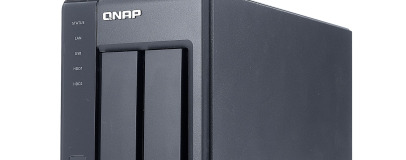
QNAP TS-219P II Turbo NAS Review
Manufacturer: QNAPUK Price (as reviewed): £286.58 (inc VAT)
US Price (as reviewed): $349 (ex tax)
QNAP is practically a household name when it comes to NAS boxes. Its single and dual-bay models are hugely popular and have usually enjoyed a large chunk of market share thanks to their easy-to-use operating system and hassle-free setup.
We certainly had no major complaints with the setup of the TS-219P last year, with the only drawbacks being slightly mediocre read and write speeds compared to Synology's offerings. Price, too, was a sore point - at over £250, the TS-219P was outdone on value due to far cheaper examples offering similar speeds.
Synology's DS211j for example, is £100 cheaper and offers similar features and speeds. At £286, the TS-219P II is even more expensive but it does pack in a few additional specs. Firstly it has a far more powerful CPU - a 2GHz Marvel Kirkwood, while the TS-219P sported a similar model clocked at 1.2GHz. The TS-219P also II uses DDR3 rather than DDR2 memory - 512MB in total. Meanwhile, the unit itself is equipped with a rear 70mm cooling fan and the two hard disk bays are hot-swappable. It also feels generally sturdier than previous models we've seen, and has large rubber feet too.
Click to enlarge
Over and above cheaper current models such as the TS-210, it also has two eSATA ports, 2.5in hard disk support, online RAID capacity expansion and level migration and Wake on LAN. Sadly, USB3 hasn't made an appearance yet - there are three USB 2 ports instead, all of which support USB mass storage devices and memory card readers as well as compatible WiFi adapters. QNAP also quotes faster data transfer speeds, particularly write speeds - more on this later.
Meanwhile, a one-touch backup button makes it easy to dump data from flash cards quickly onto the NAS without having to log-in to a PC. In addition to UPnP media streaming support, a downloadable add-on also provides Logitech Squeezebox server support - a feature that's often been previously limited to a select few NAS box manufacturers such as Netgear.
Getting started is the usual hassle-free affair to which we've become accustomed with QNAP's products - with less than 15 minutes being required to connect everything up, install QNAP Finder to locate and setup the NAS and upload and install the latest firmware, either from the included CD or from QNAP's website.
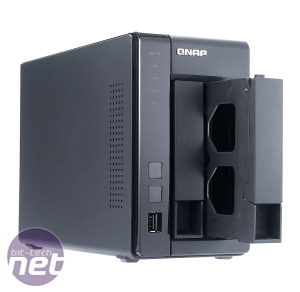
During the install, you can also enable various useful features such as the UPnP server, BitTorrent-equipped Download Station and iTunes server. These are ready to roll once you're at the main OS page, with the iTunes server able to be linked to clients on the same subnet, for example.
QNAP's operating system hasn't changed much since we last looked at one of its products - unlike Synology, which rolled out a major overhaul of its DSM OS last year. This isn't necessarily bad, though, as it was already a great OS, complete with handy colour-coded sections and icons. The latter have been tweaked in some areas to better-represent their meaning too, which is great if you're a newcomer, as the detestable textual lists you find in some NAS boxes are enough to put of most people at the start.
Meanwhile, a column on the left of the main interface houses the main tabs, such as System Admin and Disk Management, while QNAP's media hub - Multimedia Station - and Download Station - can be found in large coloured icons at the top of the screen, presumably because they're likely to be your most common ports of call.
Download Station has also received a few tweaks since we last used it - a better-equipped BitTorrent client now has more options for bandwidth control and the ability to move completed torrents to a separate directory. The scheduler and other options still aren't as granular as popular clients out there, but it's still one of the best NAS-integrated download systems we've used. The extra CPU power should allow for plenty of concurrent torrents too - often a fail point with NAS boxes equipped with lowly CPUs.
As you'd expect from a modern NAS, there's also iSCSI support, enabling you to map a network folder or volume as a local drive, rather than a mapped network one - this can be useful for certain situations such as media PC streaming and video playback. As with many NAS boxes we've seen recently, Cloud backup is supported too, specifically via Amazon's S3 service or a QNAP-optimised version of Elephant Drive, both of which are paid-for services. Using an app called QMobile, you're also able to share data between the NAS and iOS or Android devices. There's plenty in the way of drive options too - the QNAP TS-219P II supports single disk configurations, as well as JBOD, RAID 0 and RAID 1 - all of which are easy to set up under the Disk Management tab.
Specifications
- Local connections Front: USB 2, Rear: 2 x USB 2, 2 x eSATA
- Network connections 1 x Gigabit Ethernet
- Storage Up to 2 x 3TB hard disks (not included)
- Cables 2m Cat 5 Ethernet,
- Wireless security N/A
- Features FTP server, webserver, photo server, independent download (via HTTP, FTP and BitTorrent), iTunes and UPnP media sever, print server, webcam host, storage server for external USB hard disks, iSCSI, Scheduled Power on/off, video surveillance, Logitech Squeezebox Server Support (via add-on)
- Weight 1.28kg
- Software Backup software
- Accessories None

MSI MPG Velox 100R Chassis Review
October 14 2021 | 15:04

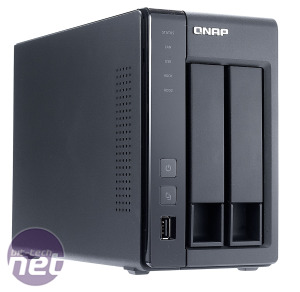
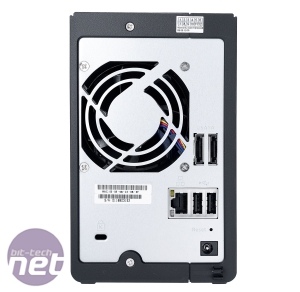
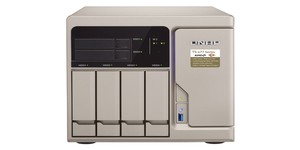
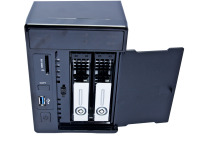





Want to comment? Please log in.